A Management Guideline Wheel for endometrial carcinomas and uterine sarcoma has been designed and developed to facilitate a standard and to improve the quality of care in management of uterine neoplasms. Each step of the wheel takes into account the context of the patient’s medical/surgical condition, FIGO/surgical stages, and the possibilities of treatment modalities for uterine neoplasms. Management guidelines were revised by comparing different existing guidelines on uterine neoplasms. This wheel is based on recommendations from the different international guidelines concerned with management of uterine neoplasms.
uterine neoplasms, endometrial carcinoma, uterine sarcoma, surgical staging, radiotherapy, chemotherapy, systemic therapy, figo, guidelines
Defining an optimal strategy for management of endometrial neoplasms is not very well established by the available evidence. As a result, different countries and societies have developed differing algorithms that vary about the steps of management following pathological results and surgical staging. We compared different guidelines which have been concerned with the management guideline of the uterine neoplasms (The National Comprehensive Cancer Network (NCCN), the Society of Gynecology (SGO), the European Society of Gynecology (ESGO), the European Society of Medical Oncology (ESMO), the British Gynecological Cancer Society (BGCS) and the International Federation of Gynecology and Obstetrics (FIGO)). The National Comprehensive Cancer Network (NCCN) clinical practice guideline for uterine neoplasms is one of the most constantly updated and comprehensive guideline, for evidence based care. So we used these different guidelines to develop a management guideline wheel which could be used as a ready reckoned for implementation of evidence based care. The idea for development of the wheel is to find a quick and completed viewing of the management steps for the oncologists (Gynae/General). It, in any way, does not replace the use of the original flowchart guidelines or the algorithms but as a facilitator. While we were developing this tool, the world is undergoing through unprecedented times of a pandemic, which had a major impact on treatment of Cancer worldwide. Although there have been multiple alternative strategies being implemented, we have restricted the wheel mainly to the defined standards of care as per the NCCN guidelines Figure 1 and Figure 2.
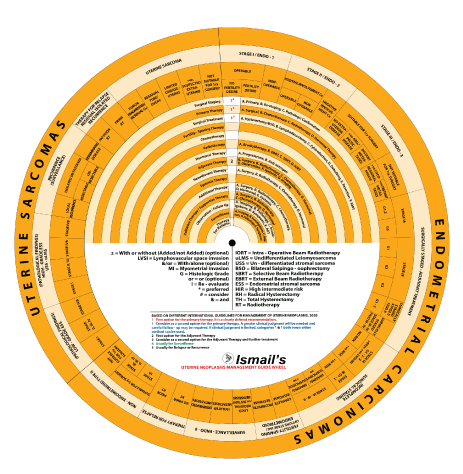
Figure 1. The use and placement of the wheel, depicting the decision making process

Figure 2. The inner wheel: depicting the choices
While defining the management of Endometrial Carcinomas and Sarcomas separately, it integrates recommendations from different guidelines addressing the management of uterine neoplasms. The wheel includes guidelines and algorithms (steps) for management of uterine neoplasms.
The wheel includes recommendation on initiating use of fifteen common modalities for management of uterine neoplasms (on the inner wheel):
1. Surgical Staging: either A: Primary, B: Re-staging, C: Pathological confirmation
2. Primary therapy: either A: Surgical, B: Chemotherapy, C: Radiotherapy or D: Hormonal Therapy
3. Surgical Treatment: either A: Hysterectomy/BSO, B: Lymphadenectomy, or C: Cytoreduction, D: Debulking, E: Resection
4. Fertility-Sparing Therapy
5. Chemotherapy
6. Radiotherapy: either A: Brachytherapy or B: EBRT, C: SBRT, D: IORT
7. Hormonal Therapy: either A: Progesterone, B: Anti-estrogen
8. Adjuvant Therapyeither: A: Surgery, B: Radiotherapy, C: Chemotherapy, D: Hormonal, E: Observation, F: Systemic, G: Imaging
9. Neoadjuvant Therapyeither: A: Surgery, B: Radiotherapy, C: Chemotherapy, D: Hormonal
10. Systemic Therapyeither: A: Surgery, B: Radiotherapy, C: Chemotherapy, D: Hormonal
11. Additional Therapyeither: A: Surgery, B: Radiotherapy, C: Chemotherapy, D: Hormonal, E: Systemic
12. Palliative Therapy / Supportive Therapyeither: A: Surgery, B: Radiotherapy, C: Chemotherapy, D: Hormonal
13. Observation / Follow up: eitherA: Imaging, B: Pathology, C: Investigations, D: Symptoms, E: ART
14. Surveillance: eitherA: Imaging, B: Investigations C: Markers, D: Pathology, E: Symptoms
15. Therapy for Relapse
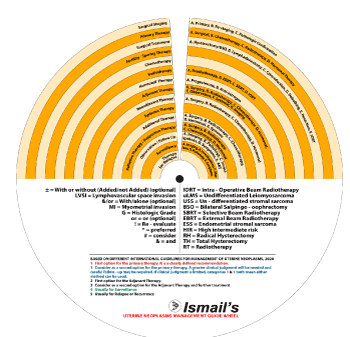
The wheel matches up the treatment modalities shown on the inner disk, with specific uterine neoplasms according to clinical, imaging, histopathological staging shown around the outer rim. The numbers shown in the viewing slot tell the gynecologists / oncologists (users) the suggested steps-order or the steps-chain whether the woman who has this known uterine neoplasms has to start and to go through [1-15].
The specific uterine neoplasm conditions shown around the outer rim are:
- Stage I endometrioid carcinoma / ENDO-1.
- Stage II endometrioid carcinoma / ENDO-2.
- Stage III endometrioid carcinoma / ENDO-3.
- Surgically staged – Adjuvant treatment.
- Incomplete surgically staged – Adjuvant treatment.
- Fertility-Sparing options Stage IA G1 endometrioid.
- Surveillance ENDO-9.
- Therapy for Relapse.
- Non-endometrioid Type II.
- Low-Grades ESS, Pathological finding, uterine sarcomas.
- High-Grades USS - uLMS, Pathological finding, uterine sarcomas.
- Recurrence (surveillance), uterine sarcomas.
- Therapy for Relapse, Residual isolated recurrence.
- Uterine sarcoma
- Uterine Neoplasms (UN-1): for clarification of uterine neoplasms
- Endometrial Carcinoma
- Disease Limited to the Uterus (ENDO-1)
- Suspected or Gross Cervical Involvement (ENDO-2)
- Suspected Extrauterine Disease (ENDO-3)
- Surveillance (ENDO-9)
- Minimally invasive surgery (MIS) is the preferred approach when technically feasible
- The degree of surgical staging to assess disease status depends on preoperative and intraoperative findings. Multidisciplinary expertise is recommended.
- The surgical goal is to have no measurable residual disease.
- Risk factors are: age, LVSI, grade 2 or 3, and depth of myoinvasion. Risk factors are continuous variables. Risk of recurrence is higher with older age (especially >60 y), extensive LVSI, and deeper myoinvasion (>50%). Also, when there are more risk factors present, the risk of recurrence is higher.
- HIR: age 50–69 y with two risk factors or age <50 y with three risk factors, or age 18 y or older with three risk factors.
- FIGO staging of endometrial carcinoma:
FIGO staging of endometrial carcinoma |
Stage I |
Stage IA |
Stage IB |
Tumor confined to the corpus uteri, including endocervical glandular involvement |
Tumor limited to the endometrium or invading less than half the Myometrium (<50%). |
Tumor invading one half or more of the Myometrium
(>50%) |
Stage II |
Tumor invading the Stromal connective tissue of the Cervix but not extending beyond the uterus. It Does NOT more include endocervical glandular involvement. |
Stage III |
Stage IIIA |
Stage IIIB |
Stage IIIC |
Stage IIIC1 |
Stage IIIC2 |
Local and/or regional spread of the tumor (Tumor involving serosa, adnexa, vagina, or parametrium) |
Tumor involving the serosa and/or adnexa (direct extension or metastasis) |
Vaginal involvement (direct extension or metastasis) or parametrial involvement |
Metastases to pelvic or para-aortic lymph nodes |
Metastases to pelvic lymph nodes |
Metastases to para-aortic lymph nodes with or without pelvic lymph nodes |
Stage IV |
Stage IVa |
Stage IVb |
Tumor invades bladder and/or bowel mucosa and / or distant metastases |
Tumor invades bladder and/or bowel mucosa |
Distant metastases including intra abdominal and / or inguinal lymph nodes |
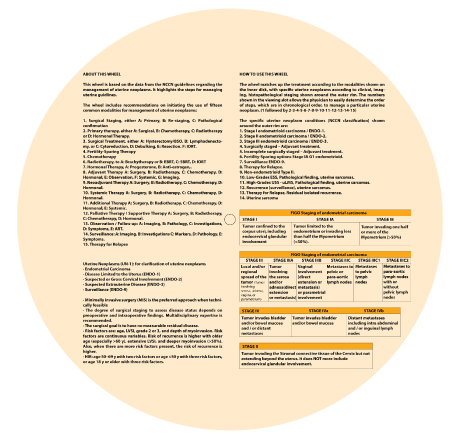
or |
or (optional) |
& |
and |
&/or |
With/alone (optional) |
* |
preferred |
# |
consider |
± |
With or without (Added/not Added) (optional |
! |
Re-evaluate |
G |
Histologic Grade |
LVSI |
Lymphovascular space invasion |
MI |
Myometrial invasion |
HIR |
High intermediate risk |
TH |
Total Hysterectomy |
RH |
Radical Hysterectomy |
BSO |
Bilateral Salpingo-oophrectomy |
ESS |
Endometrial stromal sarcoma |
USS |
Un-differentiated stromal sarcoma |
uLMS |
Undifferentiated Leiomyosarcoma |
RT |
Radiotherapy |
EBRT |
External Beam Radiotherapy |
SBRT |
Selective Beam Radiotherapy |
IORT |
Intra-Operative Beam Radiotherapy |
RT |
Radiotherapy |
1 |
First option for the primary therapy. It is clearly defined recommendation. |
1 |
Consider as a Second option for the primary therapy. A greater clinical judgment will be needed and careful follow-up may be required. If clinical judgment is limited, categories 1& 1 both mean the method can be used. |
2 |
First option for the Adjuvant therapy |
3 |
Consider as a Second option for the Adjuvant therapy and Further treatments |
4 |
Usually for Surveillance |
5 |
Usually for Relapse or Recurrence |

- Sector one: Management of Stage I endometrioid carcinoma / ENDO-1
- Stage I / ENDO-1, Operable, Non-Fertility Desire: The first option is surgical staging with primary surgical treatment with hysterectomy and bilateral Salpingo-oophrectomy. The second step is adjuvant therapy.
Stage I / Endo-1 |
Non-Fertility Desire → Operable → Stage I / ENDO-1 |
Steps |
Actions |
1 A |
→ Surgical Staging Primary |
1A |
→ Primary Therapy Surgical |
1A |
→Surgical Treatment Hysterectomy/BSO |
2 |
→ Adjuvant Therapy |
- Stage I / ENDO-1, Operable, Fertility Desire: The only option is to follow the guideline of fertility – sparing therapy.
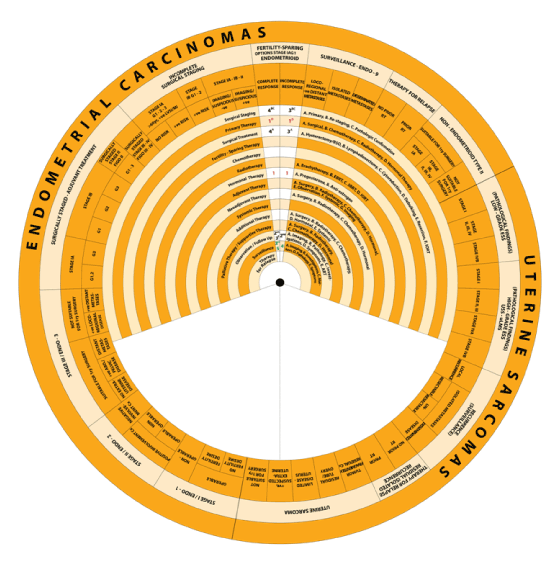
Stage I / Endo-1 |
Fertility Desire → Operable → Stage I / ENDO-1 |
Steps |
Actions |
1 |
→ Fertility-Sparing Therapy |
- Stage I / ENDO-1, Non- Operable: The first option is radiotherapy (brachytherapy + EBRT) as a primary therapy. The second step is the surveillance pass way.
Stage I / Endo-1 |
Non-Operable → Stage I / ENDO-1 |
Steps |
Actions |
1C |
→ Primary Therapy Radiotherapy |
1A+B |
→Radiotherapy Brachytherapy + EBRT |
2 |
→ Surveillance |
Sector one: Management of Stage II endometrioid carcinoma / ENDO-2

- Stage II / ENDO-2, Positive involvement of Cervix, Operable: The first option is surgical staging with primary surgical treatment with hysterectomy and bilateral Salpingo-oophrectomy. Another alternative option as a primary therapy is radiotherapy (EBRT + brachytherapy). The second step is the Surveillance pass-way.
Stage II / Endo-2 |
Operable → Positive involvement of Cervix → Stage II / ENDO-2 |
Steps |
Actions |
1 A |
→ Surgical Staging Primary |
1A-C |
→ Primary Therapy Surgical -/or Radiotherapy |
1A |
→Surgical Treatment Hysterectomy/BSO |
or1B+A |
→ or Radiotherapy EBRT + Brachytherapy |
2 |
→ Surveillance |
- Stage II / ENDO-2, Positive involvement of Cervix, Non-Operable: The first option is Radiotherapy (EBRT+ brachytherapy) as a primary therapy. Another alternative option as a primary therapy is the addition of Systemic therapy to the radiotherapy or to use Systemic therapy alone as a primary therapy. The second step is the surgical resection or Radiotherapy (Brachytherapy) if it has not been used. The third step is the Surveillance pass-way.
Stage II / Endo-2 |
Non-Operable → Positive involvement of Cervix → Stage II / ENDO-2 |
Steps |
Actions |
1C |
→ Primary Therapy Radiotherapy |
1B+A |
→ Radiotherapy EBRT + Brachytherapy |
±1 |
→± Systemic Therapy |
or1 |
→ or Systemic Therapy |
or1B+A |
→ or Radiotherapy EBRT + Brachytherapy |
2E |
→ Surgical Treatment Resection |
2A |
→ Radiotherapy Brachytherapy |
3 |
→ Surveillance |
- Stage II / ENDO-2, Negative involvement of Cervix: The first option is surgical staging with primary surgical treatment with hysterectomy and bilateral Salpingo-oophrectomy. The second step is Adjuvant Therapy. The third step is the Surveillance pass-way.
Stage II / Endo-2 |
Negative involvement of Cervix → Stage II / ENDO-2 |
Steps |
Actions |
1 A |
→ Surgical Staging Primary |
1A |
→ Primary Therapy Surgical |
1A |
→Surgical Treatment Hysterectomy/BSO |
2 |
→ Adjuvant Therapy |
3 |
→ Surveillance |
- Sector three: Management of Stage III - IV / Endo-3

- Suspected extrauterine Disease: Suitable for Primary Surgery → No Extrauterine Disease → Stage I / ENDO-1: The first option is surgical staging with primary surgical treatment with hysterectomy and bilateral Salpingo-oophrectomy. The second step is Adjuvant Therapy. The third step is the Surveillance pass-way.
Suspected extrauterine Disease →Stage III - IV / Endo-3 |
Suitable for Primary Surgery → No Extrauterine Disease → Stage I / ENDO-1 |
Steps |
Actions |
1 A |
→ Surgical Staging Primary |
1A |
→ Primary Therapy Surgical |
1A |
→Surgical Treatment Hysterectomy/BSO |
2 |
→ Adjuvant Therapy |
3 |
→ Surveillance |
- Positive Abdominal / Pelvic confined Disease → Suitable for Primary Surgery → Stage III- IV / ENDO-3: The first option is surgical staging with primary surgical treatment with hysterectomy and bilateral Salpingo-oophrectomy and Debulking. The second option in the primary therapy is to consider a preoperative chemotherapy. The second step is Adjuvant Therapy. The third step is the Surveillance pass-way.
Suspected extrauterine Disease →Stage III - IV / Endo-3 |
Positive Abdominal / Pelvic confined Disease → Suitable for Primary Surgery → Stage III- IV / ENDO-3 |
Steps |
Actions |
1A |
→ Surgical Staging Primary |
1A |
→ Primary Therapy Surgical |
1A+D |
→ Surgical Treatment Hysterectomy/BSO + Debulking |
#/ pre-op 1 |
→ consider/ pre-op Chemotherapy |
2 |
→ Adjuvant Therapy |
3 |
→ Surveillance |
- Stage III- IV / ENDO-3 →Positive Distant Metastases → Suitable for Primary Surgery: The first option is Systemic Therapy. The second option in the primary therapy is Radiotherapy (EBERT and /or SBRT) either in combination with the systemic therapy or alone. The third option in the primary therapy is to consider palliative Therapy (TH/BSO). The second step is the Surveillance pass-way.
Suspected extrauterine Disease →Stage III - IV / Endo-3 |
Positive Distant Metastases → Suitable for Primary Surgery → Stage III- IV / ENDO-3 |
Steps |
Actions |
1 |
→ Systemic Therapy |
&/or 1B±C |
→ &/or Radiotherapy EBRT &/or SBRT |
#1A |
→ consider Palliative Therapy Surgery-Hysterectomy/BSO |
2 |
→ Surveillance |
- Stage III- IV / ENDO-3 →Positive Locoregional disease → Not Suitable for Primary Surgery: The first option is Radiotherapy (EBERT ± Brachytherapy). The second option in the primary therapy is ± Systemic Therapy. The third option in the primary therapy is to consider surgical treatment (Resection). The second step is the Surveillance pass-way.
Suspected extrauterine Disease →Stage III - IV / Endo-3 |
Positive Locoregional Disease → Not Suitable for Primary Surgery → Stage III- IV / ENDO-3 |
Steps |
Actions |
1B±A |
→ Radiotherapy EBRT ± Brachytherapy |
±1 |
→± Systemic Therapy |
#2E |
→ consider Surgical treatment Resection |
3 |
→ Surveillance |
- Stage III- IV / ENDO-3 →Positive Distant Metastases → Not Suitable for Primary Surgery: The first option is Systemic Therapy. The second step is re-evaluation for possible surgical treatment (Resection) ± Radiotherapy. The third step is the Surveillance pass-way.
Suspected extrauterine Disease →Stage III - IV / Endo-3 |
Positive Distant Metastases → Not Suitable for Primary Surgery → Stage III- IV / ENDO-3 |
Steps |
Actions |
1 |
→ Systemic Therapy |
!2E |
→ re-evaluate Surgical treatment Resection |
!±2E |
→ re-evaluate / ± Radiotherapy |
3 |
→ Surveillance |
- Surgically staged – Adjuvant treatment
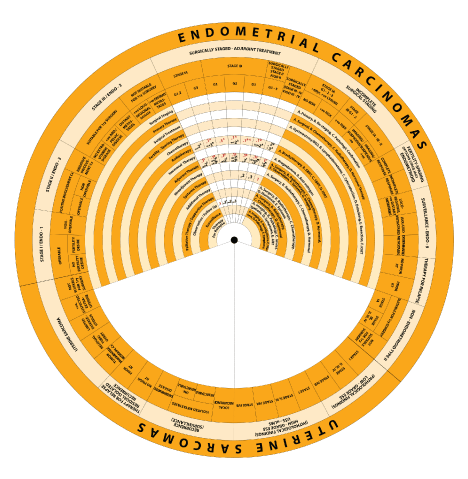
- Surgically Staged → Stage IA G1-2 → Adjuvant Therapy: The first option in the adjuvant treatment is Observation. The second step in Adjuvant Therapy is Radiotherapy (Brachytherapy) especially in HIR.
Complete Surgically Staged (FIGO Stages) →Adjuvant Treatment |
Stage IA G1-2 → Adjuvant Therapy → Surgically Staged |
Steps |
Actions |
*1E |
→Preferred Adjuvant Therapy Observation |
*1 |
→Preferred Observation |
or#2B |
→ or /Consider Adjuvant Therapy Radiotherapy – Brachytherapy (HIR) |
or#2A |
→ or /Consider Radiotherapy Brachytherapy (HIR) |
- Surgically Staged → Stage IA G3 → Adjuvant Therapy: The first option in the adjuvant treatment is Radiotherapy (Brachytherapy) which is the preferred option. The second step in Adjuvant Therapy is to consider Observation, while the third step is to consider Radiotherapy (EBRT) especially in HIR.
Complete Surgically Staged (FIGO Stages) →Adjuvant Treatment |
Stage IA G3 → Adjuvant Therapy → Surgically Staged |
Steps |
Actions |
*1B |
→Preferred Adjuvant Therapy Radiotherapy |
*1A |
→Preferred Radiotherapy Brachytherapy |
or#2E |
→ or /Consider Adjuvant Therapy Observation |
or#2A |
→ or /Consider Observation |
or#3B |
→ or /Consider Adjuvant Therapy Radiotherapy (HIR) |
or#3B |
→ or /Consider Radiotherapy EBRT (HIR) |
- Surgically Staged → Stage IB G1 → Adjuvant Therapy: The first option in the adjuvant treatment is Radiotherapy (Brachytherapy) which is the preferred option especially in HRI. The second step in Adjuvant Therapy is to consider Observation.
Complete Surgically Staged (FIGO Stages) →Adjuvant Treatment |
Stage IB G1 → Adjuvant Therapy → Surgically Staged |
Steps |
Actions |
*1B |
→ Preferred Adjuvant Therapy Radiotherapy – Brachytherapy (HIR) |
*1A |
→ Preferred Radiotherapy Brachytherapy (HIR) |
or#2E |
→ or /Consider Adjuvant Therapy Observation |
or#2 |
→ or /Consider Observation |
- Surgically Staged → Stage IB G2 → Adjuvant Therapy: The first option in the adjuvant treatment is Radiotherapy (Brachytherapy) which is the preferred option. The second step in Adjuvant Therapy is to consider Radiotherapy (EBRT), especially in HRI. The third step is to consider Observation especially with no HIR.
Complete Surgically Staged (FIGO Stages) →Adjuvant Treatment |
Stage IB G2 → Adjuvant Therapy → Surgically Staged |
Steps |
Actions |
*1B |
→Preferred Adjuvant Therapy Radiotherapy |
*1A |
→Preferred Radiotherapy Brachytherapy |
or#2E |
→ or /Consider Adjuvant Therapy Radiotherapy |
or#2A |
→ or /Consider Radiotherapy EBRT (HIR) |
or#3E |
→ or /Consider Adjuvant Therapy Observation (No HIR) |
or#3 |
→ or /Consider Observation |
- Surgically Staged → Stage IB G3 → Adjuvant Therapy: The first option in the adjuvant treatment is Radiotherapy (EBER - Brachytherapy) which is the preferred option. The second step in Adjuvant Therapy is ± Systemic Therapy.
Complete Surgically Staged (FIGO Stages) →Adjuvant Treatment |
Stage IB G3 → Adjuvant Therapy → Surgically Staged |
Steps |
Actions |
*1B |
→ Preferred Adjuvant Therapy Radiotherapy |
*1B-A |
→ Preferred Radiotherapy EBER - Brachytherapy |
±2F |
→ ±Adjuvant Therapy Systemic Therapy |
±2 |
→ ±Systemic Therapy |
- Surgically Staged → Stage IIB G 1-3 → Adjuvant Therapy: The first option in the adjuvant treatment is Radiotherapy (EBER) which is the preferred option. The second step in Adjuvant Therapy is and /or Radiotherapy (Brachytherapy). The third step is ± Systemic Therapy.
Complete Surgically Staged (FIGO Stages) → Adjuvant Treatment |
Stage II G1-3 → Adjuvant Therapy → Surgically Staged |
Steps |
Actions |
*1B |
→Preferred Adjuvant Therapy Radiotherapy |
*1B |
→Preferred Radiotherapy EBRT |
&/or2B |
→ &/or Adjuvant Therapy Radiotherapy |
&/or2A |
→ &/or Radiotherapy Brachytherapy |
±3F |
→ ±Adjuvant Therapy Systemic Therapy |
±3 |
→ ±Systemic Therapy |
- Surgically Staged → Stage III - IV3 → Adjuvant Therapy: The first option in the adjuvant treatment is Systemic Therapy. The second step in Adjuvant Therapy is ± Radiotherapy (EBRT). The third step is ± Radiotherapy (Brachytherapy).
Complete Surgically Staged (FIGO Stages) →Adjuvant Treatment |
Stage III-IV → Adjuvant Therapy → Surgically Staged |
Steps |
Actions |
1F |
→ Adjuvant Therapy Systemic Therapy |
1 |
→ Systemic Therapy |
±2B |
→ ±Adjuvant Therapy Radiotherapy |
±2B |
→ ±Radiotherapy EBRT |
±3B |
→ ±Adjuvant Therapy Radiotherapy |
±3A |
→ ±Radiotherapy Brachytherapy |
- Incomplete surgically staged – Adjuvant treatment
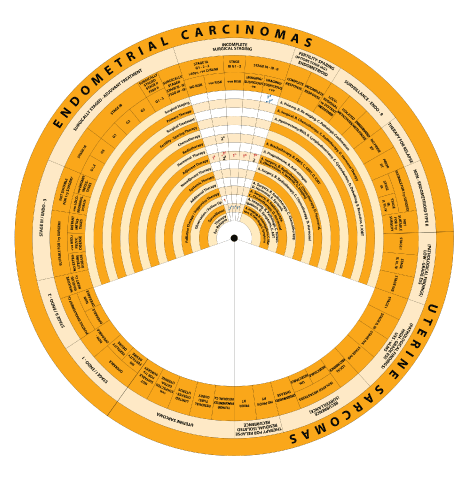
- Stage IA G1-2 → No Risk Factors (-ve LVSI, age <60 yrs): The only option in the adjuvant treatment is Observation / Follow up.
Incompletely Surgically Staged (FIGO Stages) →Adjuvant Treatment |
Stage IA G1-2 → No Risk Factors (-ve LVSI, age <60 yrs) → Adjuvant Therapy → Incomplete Surgically Staged |
Steps |
Actions |
1E |
→ Adjuvant Therapy Observation / Follow up |
1 |
→ Observation / Follow up |
- Stage IA G3 → No Risk Factors (age <60 yrs, -ve LVSI, and no myometrial invasion): The only option in the adjuvant treatment is Observation / Follow up.
Incompletely Surgically Staged (FIGO Stages) →Adjuvant Therapy |
Stage IA G3 → No Risk Factors (age <60 yrs, -ve LVSI, no myometrial invasion) → Adjuvant Therapy → Incompletely Surgically Staged |
Steps |
Actions |
1E |
→ Adjuvant Therapy Observation / Follow up |
1 |
→ Observation / Follow up |
- Stage IA G3, Stage IB G1-2 → with Risk Factors → Adjuvant Therapy →Incompletely surgically Staged: The first option in the adjuvant treatment is to consider Surveillance (Imaging). The second step in Adjuvant Therapy is ± Radiotherapy (Brachytherapy).
Incompletely Surgically Staged (FIGO Stages) →Adjuvant Treatment |
Stage IA G3, Stage IB G1-2 → with Risk Factors → Adjuvant Therapy →Incompletely Surgically Staged |
Steps |
Actions |
#1G |
→ Consider Adjuvant Therapy Imaging |
#1A |
→Consider Surveillance Imaging |
2B |
→ Adjuvant Therapy Radiotherapy |
2A |
→ Radiotherapy Brachytherapy |
- Negative Imaging → Stage IA G1-3, Stage IB G1-2 with Risk Factors (+LVSI) and Stage IB G3, Stage II → Adjuvant Therapy → incompletelysurgicallystaged: The only option in the adjuvant treatment is Surveillance (Imaging).
Incompletely Surgically Staged (FIGO Stages) →Adjuvant Therapy |
Negative Imaging → Stage IA G1-3, Stage IB G1-2 with Risk Factors (+LVSI) and Stage IB G3, Stage II → Adjuvant Therapy → Incompletely Surgically Staged |
Steps |
Actions |
1G |
→ Adjuvant Therapy Imaging |
1A |
→ Surveillance Imaging →ENDO-1 |
- Suspicious / Positive imaging → Stage IA G1-3, Stage IB G1-2 with Risk Factors (+LVSI) and Stage IB G3, Stage II → Adjuvant Therapy → incompletely surgically staged: The first option in the adjuvant treatment is imaging. The second option is surgical re-staging and pathologic confirmation. Then Adjuvant therapy.
Incompletely Surgically Staged (FIGO Stages) →Adjuvant Therapy |
Suspicious / Positive Imaging → Stage IA G1-3, Stage IB G1-2 with Risk Factors (+LVSI) and Stage IB G3, Stage II → Adjuvant Therapy → incompletely Surgically Staged |
Steps |
Actions |
1G |
→ Adjuvant Therapy Imaging |
1B |
→ Surgical Staging Re-staging |
or1C |
→ or Surgical Staging Pathologic Confirmation |
2 |
→ Adjuvant Therapy |
- Surgical Re-staging → Stage IA G1-3, Stage IB G1-2 with Risk Factors (+LVSI) and Stage IB G3, Stage II → Adjuvant Therapy → incompletely surgically staged: The first option in the adjuvant treatment is surgery. The second option is surgical re-staging. Then Adjuvant therapy.
Incompletely Surgically Staged (FIGO Stages) →Adjuvant Therapy |
Surgical Re-staging → Stage IA G1-3, Stage IB G1-2 with Risk Factors (+LVSI) and Stage IB G3, Stage II → Adjuvant Therapy → Surgically Staged |
Steps |
Actions |
1A |
→ Adjuvant Therapy Surgery |
1B |
→ Surgical Staging Re-staging |
2 |
→ Adjuvant Therapy |
- Fertility-Sparing options Stage IA G1 endometrioid
- Stage IA G1 → Complete Response for Hormonal Therapy: The first option in primary therapy is hormonal therapy (for 3 – 6 months). The second step is Observation/ Follow-up (Imaging, Pathology, Symptoms). The third step is ART followed by surveillance (Imaging, Pathology, Symptoms). This will be followed by Surgical staging (Re-staging, Pathology confirmation) and followed by surgical treatment (Hysterectomy/BSO). By the end Surveillance will be the last step.
Fertility-Sparing Options for Management of Endometrial Carcinoma |
Stage IA G1 → Complete Response for Hormonal Therapy |
Steps |
Actions |
1D |
→ Primary Therapy Hormonal |
1 |
→ Hormonal Therapy 3 – 6 months |
2ABE |
→ Observation / Follow-up Imaging, Pathology, Symptoms |
3F |
→ Observation / Follow-up ART |
3 ADE |
→ Surveillance Imaging, Pathology, Symptoms |
4 BC |
→ Surgical Staging Re-staging, Pathology confirmation |
4 A |
→ Surgical Treatment Hysterectomy/BSO |
5 |
→ Surveillance |
- Stage IA G1 → Incomplete Response for Hormonal Therapy: The first option in primary therapy is further hormonal therapy (for further 3 – 6 months). The second step is Observation/ Follow-up (Imaging, Pathology, Symptoms). The third step is ART followed by surveillance (Imaging, Pathology, Symptoms). This will be followed by Surgical staging (Re-staging, Pathology confirmation) and followed by surgical treatment (Hysterectomy/BSO). By the end Surveillance will be the last step.
Fertility-Sparing Options for Management of Endometrial Carcinoma |
Stage IA G1 → Incomplete Response for Hormonal Therapy |
Steps |
Actions |
1D |
→ Primary Therapy Hormonal therapy |
1 |
→ Hormonal Therapy 3 – 6 months |
2ABE |
→ Observation / Follow-up Imaging, Pathology, Symptoms |
3 BC |
→ Surgical Staging Re-staging, Pathology confirmation |
3A |
→ Surgical Treatment Hysterectomy/BSO |
4 |
→ Surveillance |
- Surveillance, ENDO-9
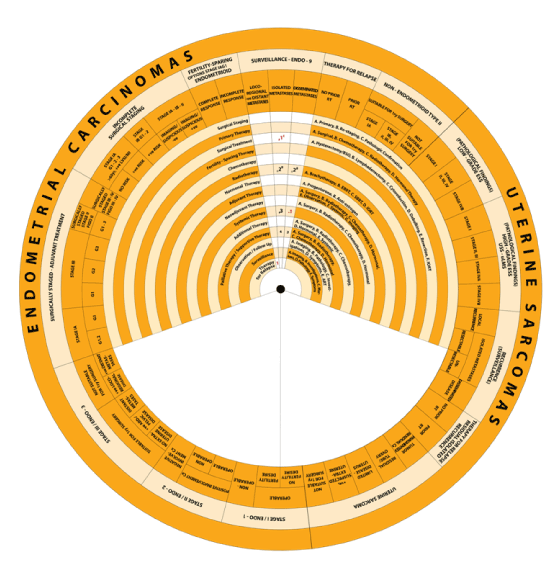
- Locoregional Recurrence → Negative Distant Metastases → Surveillance: The only option is therapy for relapse.
Surveillance in Management of Endometrial Carcinoma |
Locoregional Recurrence → Negative Distant Metastases → Surveillance |
Steps |
Actions |
1 |
→ Therapy for Relapse |
- Isolated Metastases → Surveillance: The first option is to consider Surgical Treatment (Resection). The second step is ± Radiotherapy (EBRT). The third step is to Consider Systemic Therapy. The last step is Palliative Therapy / Supportive Therapy.
Surveillance in Management of Endometrial Carcinoma |
Isolated Metastases → Surveillance |
Steps |
Actions |
#1E |
→ Consider Surgical Treatment Resection |
±2B |
→±Radiotherapy EBRT |
#3 |
→ Consider Systemic Therapy |
4 |
→ Palliative Therapy / Supportive Therapy |
- Disseminated Metastases → Surveillance: The preferred option is to consider Systemic therapy. The second step is ± Radiotherapy (EBRT). The third step is Palliative Therapy / Supportive Therapy.
Surveillance in Management of Endometrial Carcinoma |
Disseminated Metastases → Surveillance |
Steps |
Actions |
*1 |
→ Preferred Systemic Therapy |
±2B |
→±Radiotherapy EBRT |
3 |
→ Palliative Therapy / Supportive Therapy |
- Therapy for Relapse

- Locoregional recurrence, Negative Distant metastases →No Prior RT: The first option as a first step is Radiotherapy (EBRT ± Brachytherapy). The second option isSurgical Treatment (Resection ±IORT). The second step is ± Systemic Therapy. The last step is Palliative Therapy / Supportive Therapy.
Therapy for Relapse in Management of Endometrial Carcinoma |
Locoregional recurrence, Negative Distant metastases →No Prior RT |
Steps |
Actions |
1B±A |
→ Radiotherapy EBRT ± Brachytherapy |
or1E±F |
→ or Surgical Treatment Resection ±IORT |
±2 |
→± Systemic Therapy |
3 |
→ Palliative Therapy / Supportive Therapy |
- Locoregional recurrence, Negative Distant metastases → Prior RT: The first option as a first step is Surgical Treatment (Resection ±IORT). The second step is±Radiotherapy. The third step is ± Systemic Therapy. The last step is Palliative Therapy / Supportive Therapy.
Therapy for Relapse in Management of Endometrial Carcinoma |
Locoregional recurrence, Negative Distant metastases → Prior RT |
Steps |
Actions |
1E±F |
→Surgical Treatment Resection ±IORT |
±2 |
→ ±Radiotherapy |
±3 |
→ ±Systemic Therapy |
4 |
→ Palliative Therapy / Supportive Therapy |
- Non-endometrioid Type II

- Stage IA →Suitable for Primary Surgery: The first step is the surgical staging as a primary therapy with further surgical treatment (Hysterectomy/BSO, Debulking. The second step is the Additional Therapy (Systemic, Radiotherapy). This is followed by Surveillance.
Management of Non-Endometrial Carcinoma |
Stage IA →Suitable for Primary Surgery |
Steps |
Actions |
1A |
→Surgical Staging Primary |
1AD |
→ Surgical Treatment Hysterectomy/BSO, Debulking |
2 E±B |
→ Additional Therapy Systemic, Radiotherapy |
3 |
→ Surveillance |
- Stage IB, II, III, IV →Suitable for Primary Surgery: The first step is the surgical staging as a primary therapy with further surgical treatment (Hysterectomy/BSO, Debulking. The second step is the Additional Therapy (Systemic, Radiotherapy) or Systemic therapy ± Radiotherapy (EBRT, ± Brachytherapy). This is followed by Surveillance.
Management of Non-Endometrial Carcinoma |
Stage IB, II, III, IV →Suitable for Primary Surgery |
Steps |
Actions |
1A |
→Surgical Staging Primary |
1AD |
→ Surgical Treatment Hysterectomy/BSO, Debulking |
2 E±B |
→ Additional Therapy Systemic, ± Radiotherapy |
2 |
→ Systemic Therapy |
±2 B±A |
→ ±Radiotherapy EBRT, ± Brachytherapy |
3 |
→ Surveillance |
- Management of Non-Endometrial Carcinoma →Non-Suitable for Primary Surgery: The option in first step is the Radiotherapy EBRT + Brachytherapy. The second option is ± Systemic Therapy or to go only for Systemic Therapy. The second step is Surgical Treatment (Resection). This is followed by Surveillance.
Management of Non-Endometrial Carcinoma |
Not Suitable for Primary Surgery |
Steps |
Actions |
1 B+A |
→ Radiotherapy EBRT + Brachytherapy |
±1 |
→ ±Systemic Therapy |
or1 |
→ or Systemic Therapy |
2E |
→ Surgical Treatment Resection |
3 |
→ Surveillance |
- Management of Uterine Sarcomas - Low-Grades ESS

- Low-Grades ESS, Pathological finding → Stage I: The option in first step is the Preferred Surgical Treatment (BSO). The second option is or Observation/Follow up (Imaging, Symptoms). This is followed by Surveillance.
Management of Uterine Sarcoma |
Low–grade ESS → Pathologic findings →Stage I |
Steps |
Actions |
*1A |
→ Preferred Surgical Treatment BSO |
or 1 AE |
→ or Observation/Follow up Imaging, Symptoms |
2 |
→ Surveillance |
- Low-Grades ESS, Pathological finding → Stage II, III, IVA: The option in first step is the Surgical Treatment (BSO). The second step is ± Hormonal Therapy (Anti-estrogen) and ± Radiotherapy (EBRT). This is followed by Surveillance.
Management of Uterine Sarcoma |
Low–grade ESS → Pathologic findings → Stage II, III, IVA |
Steps |
Actions |
1A |
→ Surgical Treatment BSO |
± 2B |
→ ± Hormonal Therapy Anti-estrogen |
±2B |
→ ± Radiotherapy EBRT |
3 |
→ Surveillance |
- Low-Grades ESS, Pathological finding → Stage IVB: The option in first step is the Surgical Treatment (BSO). The second step is ± Hormonal Therapy (Anti-estrogen) and ± Palliative Radiotherapy (EBRT). This is followed by Surveillance.
Management of Uterine Sarcoma |
Low–grade ESS → Pathologic findings → Stage IVB |
Steps |
Actions |
1A |
→ Surgical Treatment BSO |
± 2B |
→ ± Hormonal Therapy Anti-estrogen |
±2B |
→ ± Palliative Radiotherapy(EBRT) |
3 |
→ Surveillance |
- Management of Uterine Sarcomas, High-Grades USS - uLMS, Pathological finding.
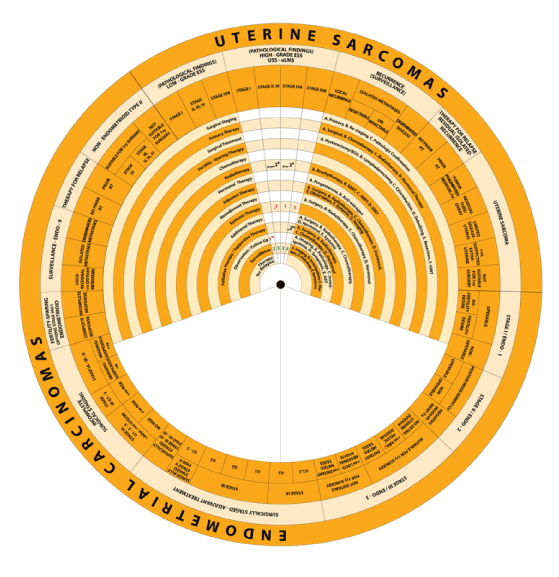
- High–grade ESS / UUS / uLMS → Pathologic findings →Stage I: The option in first step is Observation/Follow up (Imaging, Symptoms). This is followed by Surveillance.
Management of Uterine Sarcoma |
High–grade ESS / UUS / uLMS → Pathologic findings →Stage I |
Steps |
Actions |
1 AE |
→ Observation/Follow up Imaging, Symptoms |
2 |
→ Surveillance |
- High–grade ESS / UUS / uLMS → Pathologic findings → Stage II, III: The first step is to consider Systemic Therapy. The second step is (and/or consider) Radiotherapy (EBRT). This is followed by Surveillance.
Management of Uterine Sarcoma |
High–grade ESS / UUS / uLMS → Pathologic findings →Stage II, III |
Steps |
Actions |
#1 |
→ consider Systemic Therapy |
&/or#2B |
→ and/orconsider Radiotherapy EBRT |
3 |
→ Surveillance |
- High–grade ESS / UUS / uLMS → Pathologic findings → Stage IVA: The first step is Systemic Therapy. The second step is (and/or) Radiotherapy (EBRT). This is followed by Surveillance.
Management of Uterine Sarcoma |
High–grade ESS / UUS / uLMS → Pathologic findings →Stage IVA |
Steps |
Actions |
1 |
→ Systemic Therapy |
&/or2B |
→ and/or Radiotherapy EBRT |
3 |
→ Surveillance |
- High–grade ESS / UUS / uLMS → Pathologic findings → Stage IVA: The first step is Systemic Therapy. The second step is (±) Palliative Therapy including Radiotherapy (EBRT). This is followed by Surveillance.
Management of Uterine Sarcoma |
High–grade ESS / UUS / uLMS → Pathologic findings →Stage IVB |
Steps |
Actions |
1 |
→ Systemic Therapy |
±2BB |
→ ±Palliative TherapyRadiotherapyEBRT |
3 |
→ Surveillance |
- Recurrence (surveillance), uterine sarcomas
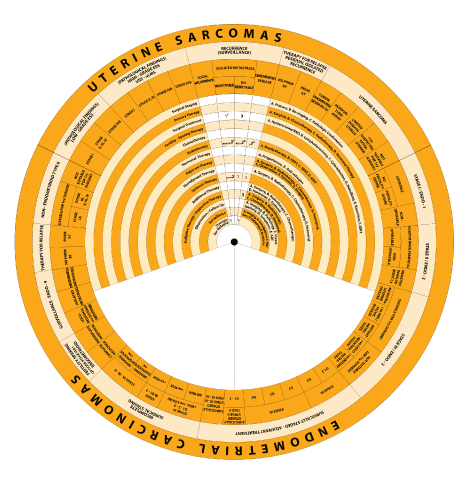
- Recurrence (Surveillance) → Local Recurrence: Follow Therapyfor Relapse.
Management of Uterine Sarcoma |
Recurrence (Surveillance) → Local Recurrence |
Steps |
Actions |
1 |
→ Therapyfor Relapse |
- Recurrence (Surveillance) → Isolated Metastases / Resectable: The first step is Follow Surgical Treatment (Resection of metastases). The second step is to (Consider/Post-Op) Systemic Therapy and to (Consider/Post-Op) Radiotherapy (EBRT).
Management of Uterine Sarcoma |
Recurrence (Surveillance) → Isolated Metastases / Resectable |
Steps |
Actions |
1E |
→ Surgical Treatment Resection metastases |
# post-Op 2 |
→ Consider/Post-Op Systemic Therapy |
# post-Op 2B |
→ Consider/Post-Op Radiotherapy EBRT |
- Recurrence (Surveillance) → Isolated Metastases / Unresectable: The first step is Systemic Therapy.The second step is to (&/or) Radiotherapy (EBRT). The third step for surgical treatment if feasible.
Management of Uterine Sarcoma |
Recurrence (Surveillance) → Isolated Metastases / Unresectable |
Steps |
Actions |
1 |
→ Systemic Therapy |
&/or2B |
→ &/or Radiotherapy EBRT |
3 |
→ Surgical Treatment |
- Recurrence (Surveillance) → Disseminated Disease: The first step is Systemic Therapy.The second step is to (±) Radiotherapy (EBRT). The third step Palliative Therapy/Supportive Care.
Management of Uterine Sarcoma |
Recurrence (Surveillance) → Disseminated Disease |
Steps |
Actions |
1 |
→ Systemic Therapy |
±2B |
→ ±Radiotherapy EBRT |
3 |
→ Palliative Therapy/Supportive Care |
- Therapy for Relapse, Residual isolated recurrence
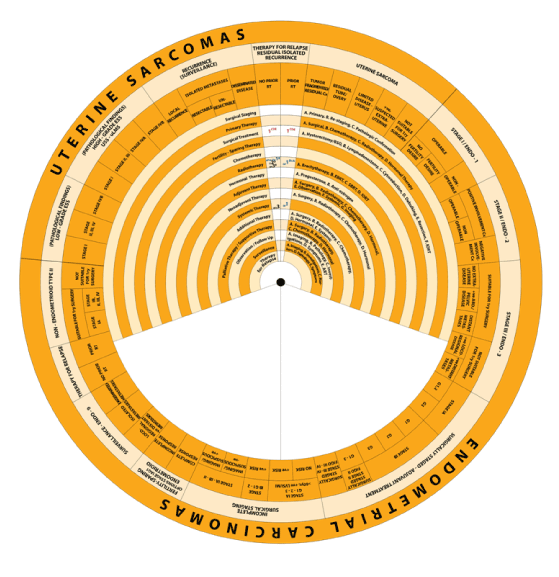
- Isolated Recurrence (Therapy for Relapse) → No Prior RT: The first step is Surgical Treatment (Cytoreduction, Debulking, and Resection). The second option in the first step is (Consider/pre-Op) Radiotherapy (EBRT). The second step is ± Radiotherapy IORT. The third step is ± Systemic Therapy, or Radiotherapy (EBRT), or/± Systemic Therapy.
Management of Uterine Sarcoma |
Isolated Recurrence (Therapy for Relapse) → No Prior RT |
Steps |
Actions |
1CDE |
→ Surgical Treatment Cytoreduction, Debulking, Resection |
#pre-Op1B |
→ Consider/pre-Op Radiotherapy EBRT |
±2D |
→ ±Radiotherapy IORT |
±3 |
→ ±Systemic Therapy |
or3B |
→ or Radiotherapy EBRT |
or±3 |
→ or± Systemic Therapy |
- Isolated Recurrence (Therapy for Relapse) → Prior RT: The first step is Surgical Treatment (Cytoreduction, Debulking, and Resection). The second option in the first step is(or) Systemic Therapy. The third option is ± Radiotherapy (EBRT± Brachytherapy).
Management of Uterine Sarcoma |
Isolated Recurrence (Therapy for Relapse) → Prior RT |
Steps |
Actions |
1CDE |
→ Surgical Treatment Cytoreduction, Debulking, Resection |
or1 |
→ or Systemic Therapy |
or1B±A |
→ or Radiotherapy EBRT± Brachytherapy |
- Management of Uterine sarcomas

- Diagnosed after Hysterectomy → Tumor initially fragmented or residual Cervix: The first step is to Consider Surgical Treatment (Resection). This is followed by Surveillance.
Management of Uterine Sarcoma |
Diagnosed after Hysterectomy → Tumor initially fragmented or residual Cervix |
Steps |
Actions |
#1E |
→ Consider Surgical Treatment Resection |
2 |
→ Surveillance |
- Diagnosed after Hysterectomy → Residual Tube/Ovary: The first step is to Consider Surgical Treatment (BSO). This is followed by Surveillance.
Management of Uterine Sarcoma |
Diagnosed after Hysterectomy → Residual Tube/Ovary |
Steps |
Actions |
#1A |
→ Consider Surgical Treatment BSO |
2 |
→ Surveillance |
- Diagnosed by Biopsy or Myomectomy → Disease limited to the uterus: The first step is to Surgical Treatment (TH ± BSO ±Resection). This is followed by Surveillance.
Management of Uterine Sarcoma |
Diagnosed by Biopsy or Myomectomy → Disease limited to the uterus |
Steps |
Actions |
1A±E |
→ Surgical Treatment TH ± BSO ± Resection |
2 |
→ Surveillance |
- Diagnosed by Biopsy or Myomectomy → Known or suspected extrauterine disease: The first step is to Surgical Treatment (TH ± BSO ± Resection of metastases). This is followed by Surveillance.
Management of Uterine Sarcoma |
Diagnosed by Biopsy or Myomectomy → Known or suspected extrauterine disease |
Steps |
Actions |
1A±E |
→ Surgical Treatment TH ± BSO ± Resection metastases |
2 |
→ Surveillance |
- Diagnosed by Biopsy or Myomectomy → Known or suspected extrauterine disease: The first step is to Systemic Therapy. The second option is &/or Palliative Therapy Radiotherapy (EBRT ± Brachytherapy). This is followed by Surveillance.
Management of Uterine Sarcoma |
Diagnosed by Biopsy or Myomectomy → Not suitable for Surgery |
Steps |
Actions |
1 |
→ Systemic Therapy |
&/or1B |
→ &/or Palliative Therapy Radiotherapy (EBRT ± Brachytherapy) |
2 |
→ Surveillance |
Endometrial neoplasms are the most common gynecological malignancy worldwide. Not all the treatment decisions in endometrial neoplasms are backed up by a robust evidence and has led to certain grey areas. These areas are addressed by different guidelines differently and at times in multidisciplinary meetings. The use of multimodality management in these cases is subjected to multidisciplinary meetings in apex institutions. But not all oncology practicing physicians and or patients have access to these multidisciplinary clinics, especially in isolated settings and/ or developing countries. The wheel has been designed and developed to facilitate the use of established standards of care and improve the quality of care in management of uterine neoplasms. It is the second comprehensive wheel to date. The wheel represents mainly the current NCCN guidelines for management of uterine neoplasms and other different guidelines (the Society of Gynecology (SGO), the European Society of Gynecology (ESGO), the European Society of Medical Oncology (ESMO), the British Gynecological Cancer Society (BGCS) and the International Federation of Gynecology and Obstetrics (FIGO), which is the most updated and comprehensive guideline which have been revised using most of the published international guidelines that exist on this subject.
Broadly, while the wheel was being developed, we categorized the factors affecting the management into three categories i.e. patient related factors, treatment factors and physician or expertise availability.
The safety of each procedure and step takes into account, the context of the patient’s medical condition. These determining factors include past medical/surgical history, patient compliance, availability of national/local healthcare facilities and patient awareness regarding the treatment modalities of uterine neoplasms. The safety of the guideline and its effectiveness as a whole should be weighed alongside with the benefits of updated and comprehensive management of uterine neoplasms. We have compared and evaluated an extensive list of Guidelines in a research paper that will be submitted for publication.
In the midst of the current COVID-19 pandemic, there has been an unprecedented change in the practice of Oncology worldwide. It has impacted the current standards of management across all stages, subtypes and risk groups. The wheel doesn’t include the changes the prominent made by the international bodies like NCCN, FIGO to circumvent the current pandemic and management of endometrial neoplasms. As we have described how the recommendations and the wheel were developed, we will now describe how to use the wheel.
This Wheel suggests 15 actions / steps in the journey for the managing of uterine neoplasms lesions:
1. Surgical Staging: either A: Primary, B: Re-staging, C: Pathological confirmation
2. Primary therapy: either A: Surgical, B: Chemotherapy, C: Radiotherapy or D: Hormonal Therapy
3. Surgical Treatment: either A: Hysterectomy/BSO, B: Lymphadenectomy, or C: Cytoreduction, D: Debulking, E: Resection
4. Fertility-Sparing Therapy
5. Chemotherapy
6. Radiotherapy: either A: Brachytherapy or B: EBRT, C: SBRT, D: IORT
7. Hormonal Therapy: either A: Progesterone, B: Anti-estrogen
8. Adjuvant Therapyeither: A: Surgery, B: Radiotherapy, C: Chemotherapy, D: Hormonal, E: Observation, F: Systemic, G: Imaging
9. Neoadjuvant Therapyeither: A: Surgery, B: Radiotherapy, C: Chemotherapy, D: Hormonal
10. Systemic Therapyeither: A: Surgery, B: Radiotherapy, C: Chemotherapy, D: Hormonal
11. Additional Therapyeither: A: Surgery, B: Radiotherapy, C: Chemotherapy, D: Hormonal, E: Systemic
12. Palliative Therapy / Supportive Therapyeither: A: Surgery, B: Radiotherapy, C: Chemotherapy, D: Hormonal
13. Observation / Follow up: eitherA: Imaging, B: Pathology, C: Investigations, D: Symptoms, E: ART
14. Surveillance: eitherA: Imaging, B: Investigations C: Markers, D: Pathology, E: Symptoms
15. Therapy for Relapse
The uterine neoplasm has been divided into 14 main divisions and under each main division all the possibilities of sub categorization. For each uterine neoplasm lesion, there are steps placed into one of 15 numbered categories. Depending upon uterine neoplasm lesion (surgical, histopathological, and imaging diagnosed) classification, more than one step may need to be considered together to determine management eligibility. These uterine neoplasm lesions classifications take into account age, surgical staging, FIGO staging, Patient fitness, imaging, histopathological diagnosis and staging, availability of the different treatment modalities, patient compliance, follow up program, availability of a gyneo-encologist, fertility desire and previous treatment interventions like hysterectomy.
Our aim through this wheel is to provide guidance to national gynecologists, oncologists, cytologists and pathologists in preparation for the policies and protocols that will be adopted for the delivery of uterine neoplasms management services. It is not meant to serve as the actual or obligatory guideline or flow chart rather an idea or a reference which need a further evaluation and feedback. The idea of the wheel can successfully apply to several international guidelines which we are continuing to work on its feasibility. In particular, the level of clinical knowledge and experience of various types of providers, availability of established programs for management and the resources available at the service delivery point will have to be taken into consideration.
No funding was received for this study.
On behalf of all authors, there have been no financial relationships in the past 36 months with entities in the bio-medical arena that could be perceived to influence, or potentially influence the submitted work.
The authors declare that they have no conflicts of interest or potential conflicts of interest as listed in the ICMJE guidelines.
- Koh WJ, Abu-Rustum NR, Bean S, Bradley K, Campos SM, et al. (2018) Uterine neoplasms, version 1.2018, NCCN clinical practice guidelines in oncology. Journal of the National Comprehensive Cancer Network 16: 170-199.
- Bruni L, Albero G, Serrano B, Mena M, Gomez D, et al. (2017) ICO information centre on HPV and cancer (HPV information centre). Human Papillomavirus and Related Diseases Report in Bahrain.
- Canadian Task Force on Preventive Health Care (2013) Recommendations on screening for cervical cancer. CMAJ 185: 34-45. [Crossref]
- Clinical Knowledge Summaries (2015) Cervical Screening.
- Saslow D, Solomon D, Lawson HW, Killackey M, Kulasingam SL, et al. (2012) American cancer society, american society for colposcopy and cervical pathology, and American society for clinical pathology screening guidelines for the prevention and early detection of cervical cancer. CA Cancer J Clin 62: 147-172. [Crossref]
- Hong HT (2019) Management guidelines for abnormal pap smear and preinvasive disease of the cervix.
- Palefsky JM (2017) Human papillomavirus infections: Epidemiology and disease associations. UpToDate.
- Arbyn M, Anttila A, Jordan J, Ronco G, Schenck U, et al. (2010) European guidelines for quality assurance in cervical cancer screening. Second Edition—Summary Document. Annals of Oncology 21: 448-458. [Crossref]
- Frumovitz M (2017) Invasive cervical cancer: Epidemiology, risk factors, clinical manifestations, and diagnosis. UpToDate.
- Peirson L, Fitzpatrick-Lewis D, Ciliska D, Warren R (2013) Screening for cervical cancer: a systematic review and meta-analysis. Systematic Reviews 2: 35. [Crossref]
- C. O. D. C. A (2015) Rationale for Screening Recommendations
- Feldman MS, Goodman M (2018) Screening for cervical cancer. UpToDate.
- World Health Organization (2013) Guidelines for screening and treatment of precancerous lesions for cervical cancer prevention.
- World Health Organization (2017) Human papillomavirus vaccines (HPV).
- Pratima K, Joshi C (2015) Application of the 2014 Bethesda system for reporting of cervical/vaginal cytological lesions. Journal of Evolution of Medical Sciences 4: 98.


















